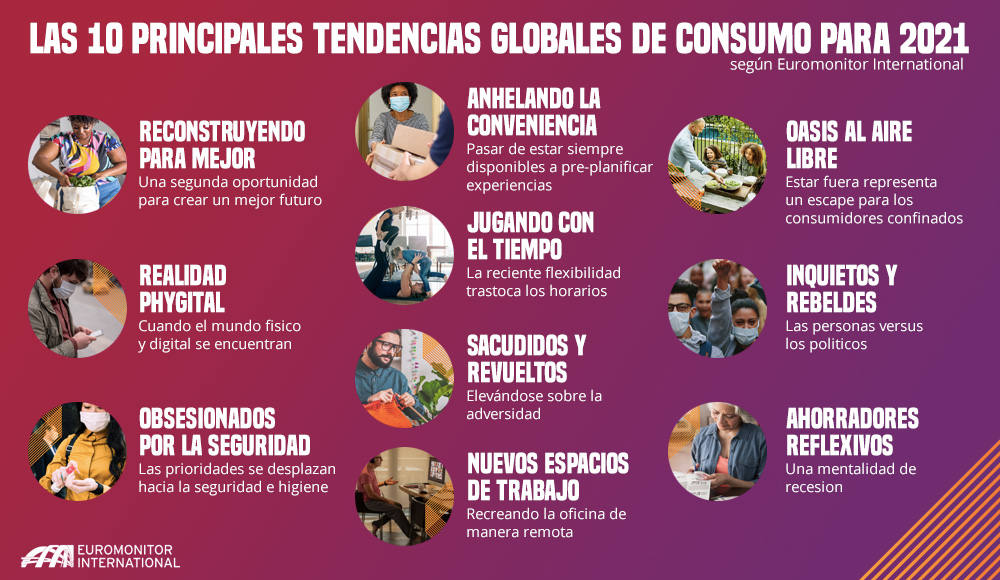
29 Oct TOP 10 GLOBAL CONSUMPTION TRENDS FOR 2021
Euromonitor International identifies emerging and rapidly evolving trends that are expected to gain ground in the following year. These trends provide insight into changing consumer values, exploring how consumer behavior shifts and how this alters business globally.
- REBUILDING FOR THE BETTER: After COVID-19, protecting the health and interests of society and the planet is the new expectation to rebuild a better future. Businesses must help reshape the world more sustainably, leading to the displacement of an economy focused on value and a turnaround toward tackling social inequalities and environmental damage. Consumers will take social and environmental issues more seriously, rewarding companies that use their profits for post-pandemic goods.
- LONGING FOR COEXISTENCE: 68% of consumers over 60 prefer to speak with human representatives. Products and services that offer solutions will drive the “Craving for Convenience” trend forward. As a result, businesses are under pressure to quickly adapt their operations to develop a resilient consumer experience and maintain convenience. Companies must preserve an agile and fluid shopping experience in all their channels; products and services that can save time, guarantee the availability of stock and fulfill your deliveries through QR codes, reservations, and identifying periods of high and low demand.
- OUTDOOR OASIS: Urban residents are looking for an outdoor Oasis that provides them with mental and physical well-being. Consumers still want to experience human connection and socialization despite the health risks associated with large group gatherings. For this reason, businesses have incorporated advanced health measures, in addition to moving their events abroad, allowing consumers to reconnect away from home more safely. Businesses should craft a product development strategy that incorporates the tranquility of rural life in urban settings to better meet the needs of citizens.
- PHYGITAL REALITY: Bringing virtual experiences at home remains imperative for driving e-commerce sales and gathering data. Video conferencing, smart gadgets, and technologies such as augmented reality (AR) and virtual reality (VR) have helped consumers form new habits around work, learning, exercise, shopping, and socializing. Businesses can integrate virtual processes into their physical spaces to give consumers who prefer to stay at home, the comfort of an adventure abroad.
- PLAYING WITH TIME: 51% of consumers chose “time to me” among their top three life priorities. Also, 46% of consumers value virtual experiences online. Consumers are reprioritizing home life for more flexibility. Companies must provide solutions that target the consumer’s desire to maximize their time, offering them greater flexibility, especially with products and services that can be accessed from or near their homes. In addition, developing a culture of 24-hour service enables businesses to define and develop offerings around consumers’ schedules. Always-on virtual services, such as on-demand entertainment and exercise programs, offer consumers similar experiences in their own homes and on their own time.
REFERENCES
Westbrook.G; Angus.A. (2021).Las 10 principales tendencias globales de consumo para 2021. Recuperado el 27 de Octubre de 2021 de https://go.euromonitor.com/rs/805-KOK-719/images/wpGCT21SPv0.3.pdf?mkt_tok=ODA1LUtPSy03MTkAAAGAV1LwIfxV0tW2zNRka8pT5LkULa44eWTp9nIqfv1nuaVMQW0CUhCYI1YcjVXNdHz1oNYFtMrR2pW5MOJTYQKOWz8iOwYWnjLAK34_m5cyRdJSrTY
